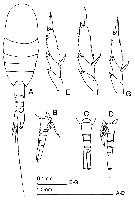|
|
 |
|
Calanoida ( Order ) |
|
|
|
Lucicutiidae ( Family ) |
|
|
|
Lucicutia ( Genus ) |
|
|
| |
Lucicutia sp. Bradford-Grieve, 1999 (F,M) | |
| | | | | | | Syn.: | ? Lucicutia flavicornis Farran (1929); Dakin & Colefax (1940) | | | | Ref.: | | | Bradford-Grieve, 1999 b (p.98, figs.F,M) |  issued from : J.M. Bradford-Grieve in The Marine Fauna of New Zealand: Pelagic Calanoid Copepoda. National Institute of Water and Atmospheric Research (NIWA). NIWA Biodiversity Memoir, 111, 1999. [p.99, Fig.64, A-D]. As Lucicutia cf. flavicornis. Female (41°41'S, 167°03'E): A, habitus (dorsal); B, urosome (lateral view); C, same (dorsal view), another specimen; D, same (lateral view); another specimen; E-G, exopod of P5 of three specimens. Nota : Head without lateral protrusions. - Genital boss large (0.61 times the length of genital segment), placed centrally on segment. Genital segment symmetrical in dorsal view. - Anal segment as long as urosome segment 3. - Caudal rami divergent or parallel and not touching, slightly more than 5 times as long as wide, innermost terminal seta small and slender. - A1 extends to posterior border of anal segment or beyond. - Basipod 2 of P1 with a low cylindrical process, endopod 3segmented. - Endopod of P5 3-segmented ; inner spine on exopod segment 2 curved and relatively thick, reaching beyond base of 1st inner seta on exopod segment 3 ; terminal spine on exopod segment 3 about half the length of its segment, outer margin of exopod segment 3 with several teeth.
|
 issued from : J.M. Bradford-Grieve in The Marine Fauna of New Zealand: Pelagic Calanoid Copepoda. National Institute of Water and Atmospheric Research (NIWA). NIWA Biodiversity Memoir, 111, 1999. [p.99, Fig.64, H-J]. As Lucicutia cf. flavicornis. Male (from same locality than female): H, habitus (dorsal); I, P5; J, basal part of P5 ( another specimen). Nota : Head without protrusions. - Anal segment almost as long as urosome segment 4. - Caudal rami are slightly more than 5 times longer than wide, innermost terminal seta small and slender. - A1 extends as far as posterior border of anal segment. - Endopod of P1 3-segmented. - Basipod 1 of right P5 with inner margin straight, basipod 2 with a rounded inner border bearing hairs. Basipod 1 of left P5 straight, basipod 2 with inner distal corner protruding and ending in one point and with 4-6 extra teeth.
| | | | | NZ: | 2 | | |
|
Distribution map of Lucicutia sp. by geographical zones
|
| | | | | | | Loc: | | | Tasman Sea, New Zealand, sub-Antarctic (W Pacific) | | | | N: | 1 | | | | Lg.: | | | (909) F: 1,2-1,70; M: 1,25-1,60; {F: 1,20-1,70; M: 1,25-1,60} | | | | Rem.: | mesopelagic.
After Bradford-Grieve (1999 b, p.99) the specimens differ from sensu stricto in that they are smaller.
The male right basipod 1 on P5 does not have the conspicuous rounded inner border, the left basipod 1 has a straight inner border, and the right basipod 2 has rounded inner border. The female is not so easily distinguished: it is smaller, P5 inner distal spine on exopod segment 2 tends to be shorter, thicker, and curved (it can also tend towards the type found in L. flavicornis sensu stricto), and the terminal spine on P5 exopod segment 3 is relatively longer. Giesbrecht (1892) appears to have figured specimens very like those from the Southwest Pacific (Taf.19, figs.15 and 18).
This form has not been described as new because there is a great deal of variability among the Southwest Pacific specimens. The identity of these specimens awaits a more detailed understanding of their variability and the molecular studies. | | | Last update : 16/01/2017 | |
|
|
 Any use of this site for a publication will be mentioned with the following reference : Any use of this site for a publication will be mentioned with the following reference :
Razouls C., Desreumaux N., Kouwenberg J. and de Bovée F., 2005-2025. - Biodiversity of Marine Planktonic Copepods (morphology, geographical distribution and biological data). Sorbonne University, CNRS. Available at http://copepodes.obs-banyuls.fr/en [Accessed December 24, 2025] © copyright 2005-2025 Sorbonne University, CNRS
|
|
 |
 |





